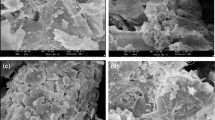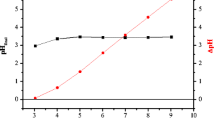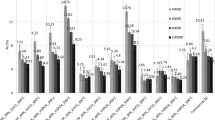Abstract
In this study, Jatropha seed shells from Yemeni plant have been tested for studying adsorption of treated seeds shells to remove chlorophenol compounds. The resulting adsorbents were designated as JAT1, JAT2 and JAT3. Most of the acidic groups on the surface were found to be phenolic in nature (37.5% in the case of JAT1 and 60% in the case of JAT). The adsorption of chlorophenol on JAT1, JAT2 and JAT3 was investigated in the temperature range 35–70 °C for initial chlorophenols concentrations ranging from 20 to 100 ppm. JAT2 was thereby found to be the best with respect to its capability to remove chlorophenols from solution indicating that thermal treatment at 500 °C is suitable to produce a good adsorbent. JAT3 is the worst in removing DCP even at high temperatures. It was also found that the removal efficiencies were in general enhanced at lower pH for all three adsorbents and for the two chlorophenols. For DCP, the corresponding heats of adsorption were found to be + 5.3, − 10.75 and − 14.4 kJ/mol. The small values for the heat of adsorption indicate that the interaction of chlorophenols with the adsorbent surface does not differ significantly from its interaction with water molecules in solution.












Similar content being viewed by others
References
Persson, Y.: Chlorinated organic pollutants in soil and groundwater at chlorophenol- contaminated sawmill. ISBN 978-91-7264-251-5 (2010)
Czaplicka, M.: Sources and transformation of chlorophenols in the natural environment, September 2003. Sci. Total Environ. 322, 21–39 (2011)
Warrington, P.D.: Water quality, ambient I water quality guidelines for chlorophenols. British Columbia Ministry of Health (1996)
Weber, R.; Gans, C.; Tysklind, M.; Johnston, P.; Forter, M.; Hollert, H.: Dioxins and persistent organic pollutants contaminated sites comemporary and future relevance and challengenes, 15, 363–393 (2012)
Tiernan, T.O.; Taylor, M.L.; Garrett, J.H.; Vanness, G.F.; Solch, J.G.; Agel, D.J.W.; Ferguson, G.L.; Schecter, A.: Sources and fate of polychlorinated dibenzodioxins, dibenzofurans and related compounds in human environments. Environ. Health Perspect. J. 59, 145–158 (1985)
Kauppinen, T.; Lindroos, L.: Chlorophenols exposure in sawmills. Am. Ind. Hygiene Assoc. J. 46, 34–38 (1985)
Carpenter, D.O.; Arcaro, K.; Spink, D.C.: Understanding the human health effect of chemical mixtures. Environ. Health Perspect. 110, 25–42 (2012)
Denizli, A.; Zkan, O.; Ucar, M.: Removal of chlorophenols from aquatic systems with dye-affinity microbeads. Sep. Purif. Technol. 24, 255–262 (2011)
Salame, I.I.; Bandosz, T.J.: Suface chemistry of activated carbons: combining the results of temperature-programmed desorption, boehm, and potentiometric titrations. J. Colloid Interface Sci. 240, 252–258 (2011)
Marwani, H.M.; Albishri, H.M.; Jalal, T.A.; Soliman, E.M.: Study of isotherm and kinetic models of lanthanum adsorption on activated carbon loaded with recently synthesized schiff’s base. Arab. J. Chem. (2013)
Cong, Y.; Wu, Z.; Tan, T.: Dechlorination by combined electrochemical reduction and oxidation. J. Zhejiang Univ. Sci. 6, 563–568 (2010)
Zielke, R.C.; Pinnavaia, T.J.: Modified clays for the adsorption of environmental toxicants: binding of chlorophenols is to pillared, delaminated and Hydroxy_interlayered Smectites. Clays Clay Min. 36, 403–408 (2013)
Xu, P.; Zeng, G.M.; Huang, D.L.; Feng, C.L.; Hu, S.; Zhao, M.H.; Lai, C.; Wei, Z.; Huang, C.: Use of iron oxide nanomaterials in waste water treatment: a review. Sci. Total Environ. 424, 1–10 (2012)
Wang, S.L.; Tzou, Y.M.; Lu, Y.H.; Sheng, G.: Removal of 3-chlorophenol from water using rice-straw-based carbon. J. Hazard. Mater. 147(3), 13–318 (2017)
Knettig, E.; Thomson, B.M.; Hrudey, S.E.: Competitive activated carbon adsorption of phenolic compounds. Environ. Pollut. Ser. B 12, 281–299 (1986)
Ali, I.; Gupta, V.K.; Aboul-Enein, H.Y.: Metal ion speciation and capillary electrophoresis: application in the new millennium. Electrophoresis 26(21), 3988–4002 (2005)
Ali, I.; et al.: Modeling of fenuron pesticide adsorption on CNTs for mechanistic insight and removal in water. Environ. Res. 170, 389–397 (2019)
Basheer, A.A.: Chemical chiral pollution: impact on the society and science and need of the regulations in the 21st century. Chirality 30(4), 402–406 (2018)
Basheer, A.A.: New generation nano-adsorbents for the removal of emerging contaminants in water. J. Mol. Liq. 261, 583–593 (2018)
Basheer, A.A.; Ali, I.: Stereoselective uptake and degradation of (±)-o, p-DDD pesticide stereomers in water-sediment system. Chirality 30(9), 1088–1095 (2018)
Ali, I.; Jain, C.K.: Groundwater contamination and health hazards by some of the most commonly used pesticides. Curr. Sci. 75(10), 1011–1014 (1998)
Nodeh, H.R.; et al.: Development of magnetic graphene oxide adsorbent for the removal and preconcentration of As (III) and As (V) species from environmental water samples. Environ. Sci. Pollut. Res. 23(10), 9759–9773 (2016)
Burakova, E.A.; et al.: Novel and economic method of carbon nanotubes synthesis on a nickel magnesium oxide catalyst using microwave radiation. J. Mol. Liquids 253, 340–346 (2018)
Ali, I.; et al.: Graphene based adsorbents for remediation of noxious pollutants from wastewater. Environ. Int. 127, 160–180 (2019)
Ali, Imran.: Microwave assisted economic synthesis of multi walled carbon nanotubes for arsenic species removal in water: batch and column operations. J. Mol. Liq. 271, 677–685 (2018)
Ali, I.; Aboul-Enein, H.Y.: Speciation of metal ions by capillary electrophoresis. Crit. Rev. Anal. Chem. 32(4), 337–350 (2002)
Ali, I.; et al.: Preparation of a carboxymethylcellulose-iron composite for uptake of atorvastatin in water. Int. J. Biol. Macromol. 132, 244–253 (2019)
Ali, I.; et al.: Kinetics, thermodynamics, and modeling of amido black dye photodegradation in water using Co/TiO2 nanoparticles. Photochem. Photobiol. 94(5), 935–941 (2018)
Ali, I.; et al.: Facile and eco-friendly synthesis of functionalized iron nanoparticles for cyanazine removal in water. Colloids Surf. B Biointerfaces 171, 606–613 (2018)
Ali, I.; et al.: Water treatment by new-generation graphene materials: hope for bright future. Environ. Sci. Pollut. Res. 25(8), 7315–7329 (2018)
Al-Shaalan, N.H.; et al.: High performance removal and simulation studies of diuron pesticide in water on MWCNTs. J. Mol. Liquids 289, 111039 (2019)
Ma, S.; Gao, F.; Lu, W.; Zhou, N.; You, H.; Li, J.; Chen, L.: Dispersive liquid-liquid microextraction coupled with pressure-assisted electrokinetic injection for simultaneous enrichment of seven phenolic compounds in water samples followed by determination using capillary electrophoresis. J. Sep. Sci. 42(13), 2263–2271 (2019)
Lu, W.; Wang, X.; Wu, X.; Liu, D.; Li, J.; Chen, L.; Zhang, X.: Multi-template imprinted polymers for simultaneous selective solid-phase extraction of six phenolic compounds in water samples followed by determination using capillary electrophoresis. J. Chromatogr. A 1483, 30–39 (2017)
Bounaas, M.; Bouguettoucha, A.; Chebli, D.; Gatica, J.M.; Vidal, H.: Role of the wild carob as biosorbent and as precursor of a new high-surface-area activated carbon for the adsorption of methylene blue. Arab. J. Sci. Eng. 1–17 (2020)
Wu, G.; Ma, J.; Li, S.; Guan, J.; Jiang, B.; Wang, L.; Chen, L.: Magnetic copper-based metal organic framework as an effective and recyclable adsorbent for removal of two fluoroquinolone antibiotics from aqueous solutions. J. Colloid Interface Sci. 528, 360–371 (2018)
Wu, G.; Ma, J.; Li, S.; Wang, S.; Jiang, B.; Luo, S.; Chen, L.: Cationic metal-organic frameworks as an efficient adsorbent for the removal of 2, 4-dichlorophenoxyacetic acid from aqueous solutions. Environ. Res. 109542 (2020)
Ma, J.; Li, S.; Wu, G.; Arabi, M.; Tan, F.; Guan, Y.; Chen, L.: Preparation of magnetic metal-organic frameworks with high binding capacity for removal of two fungicides from aqueous environments. J. Ind. Eng. Chem. 90, 178–189 (2020)
Wang, L.; Li, J.; Wang, J.; Guo, X.; Wang, X.; Choo, J.; Chen, L.: Green multi-functional monomer based ion imprinted polymers for selective removal of copper ions from aqueous solution. J. Colloid Interface Sci. 541, 376–386 (2019)
Akhlaghian, F.; Ghadermazi, M.; Chenarani, B.: Removal of phenolic compounds by adsorption on nano structured aluminosilicates. J. Environ. Chem. Eng. 1–7 (2013)
Weber, T.W.; Chakravorti, R.K.: Pore and solid diffusion models for fixed bed adsorbents. J. Am. Inst. Chern. Eng. 20, 228–238 (2011)
Ahmaruzzaman, M.: A review on the Utilization of Fly Ash. Prog. Energy Combust. Sci. 36, 327–363 (2010)
Goertzen, S.L.; Theriault, K.D.; Oickle, A.M.; Tarasuk, A.C.; Andreas, H.A.: Standardization of the Boehm titration: part I CO2 expulsion and endpoint determination. Carbon 48, 1252–1261 (2010)
Oickle, A.M.; Goertzen, S.L.; Hopper, K.R.; Abdulla, Y.O.; Andreas, H.A.: Standardization of the Boehm titration: part 11, method of agitation, effect of filtering, and dilute titrant. Carbon 48(33), 13–3322 (2010)
Friestad, H.O.: Analyt. Chem. (1969) XLI 1750-1754
Radovic, L.; Moreno-Castilla, C.; Rivera-Utrilla, J.: Carbon materials as adsorbents in aqueous solutions. In: Radovic, L. (ed.) Chemistry and Physics of Carbon, vol. 27. Mercel Dekker, New York (2011)
Author information
Authors and Affiliations
Corresponding author
Rights and permissions
About this article
Cite this article
Alkhawlani, A., Howladar, S.M. Removal of Chlorophenols Compounds Using Treated Jatropha Seed Shells Adsorbents: Characterization and Thermodynamic. Arab J Sci Eng 47, 485–496 (2022). https://doi.org/10.1007/s13369-020-05329-1
Received:
Accepted:
Published:
Issue Date:
DOI: https://doi.org/10.1007/s13369-020-05329-1




